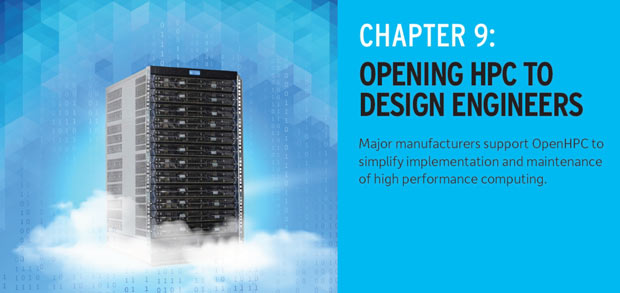Opening Up HPC to Design Engineers
Latest News
March 1, 2016
 Dear Desktop Engineering Reader:
Dear Desktop Engineering Reader:
Big data and the data-crunching, data-mining capacity of high-performance computing (HPC) are made for one another. But HPC has mostly been the province of large companies and research outfits. Small- and mid-sized businesses (SMBs), especially those engaged in simulation work, have implemented HPC at a slower pace than big companies because of picky details like IT resources and cash. That, however, is changing fast. Today’s Check it Out link takes you to an excellent report explaining why.
“Opening HPC to Design Engineers,” chapter 9 of The Design Engineer’s High-Performance Computing Handbook from Desktop Engineering and Intel, offers an evenhanded and wide-ranging analysis of many trends that are making HPC systems a viable option for engineering workflows at SMBs. You’ll be engrossed in this one quickly.“Democratizing” is the buzzword you frequently hear to describe what’s afoot in HPC these days. “Crowdsource” works too, since many HPC tools available to SMBs were born in the open source community and are free. That’s about as low-cost as you can get, but it also runs the risk of muddled code testing and validation. Pivoting off that point, chapter 9 offers an extensive report on OpenHPC, a foundation working to manage the efforts of the crowd to develop a new, open source framework for HPC environments that’s validated and affordable.
But don’t think crowdsourced means idealistic code jocks as mainstream media often portrays it. Major hardware and software developers such as ANSYS, Altair, Dell, HP, Lenovo and the Linux Foundation have embraced the open source movement. Their rationale is clear: If the entry, implementation and maintenance costs become acceptable to more SMBs, they’ll move more hardware and software as well as provide consultative services.
This point is the segue for the chapter to explore key developments like shared engineering clusters, workload management software and HPC scalability. It reports on Intel’s efforts to create a framework for any size HPC system and devise new technologies to interconnect networks, parallel processing, storage and all the components that are in an HPC setup.
 “Opening HPC to Design Engineers,” chapter 9 of The Design Engineer’s High-Performance Computing Handbook from Desktop Engineering in partnership with Intel, reports on how technology advances coupled with a collection of users, manufacturers and developers are making HPC an affordable solution for small- and mid-sized engineering businesses.
“Opening HPC to Design Engineers,” chapter 9 of The Design Engineer’s High-Performance Computing Handbook from Desktop Engineering in partnership with Intel, reports on how technology advances coupled with a collection of users, manufacturers and developers are making HPC an affordable solution for small- and mid-sized engineering businesses.“Opening HPC to Design Engineers,” chapter 9 of The Design Engineer’s High-Performance Computing Handbook, is riveting. The growing availability of affordable HPC hardware and easy-to-use software will mean complex, large-scale simulations will soon be an everyday feature in more SMBs in more industries. That’s exciting. Hit today’s Check it Out link to download your copy of this provocative read.
Thanks, Pal. — Lockwood.
Anthony J. Lockwood
Editor at Large, Desktop Engineering
Subscribe to our FREE magazine, FREE email newsletters or both!
Latest News
About the Author
Anthony J. Lockwood is Digital Engineering’s founding editor. He is now retired. Contact him via [email protected].
Follow DE





